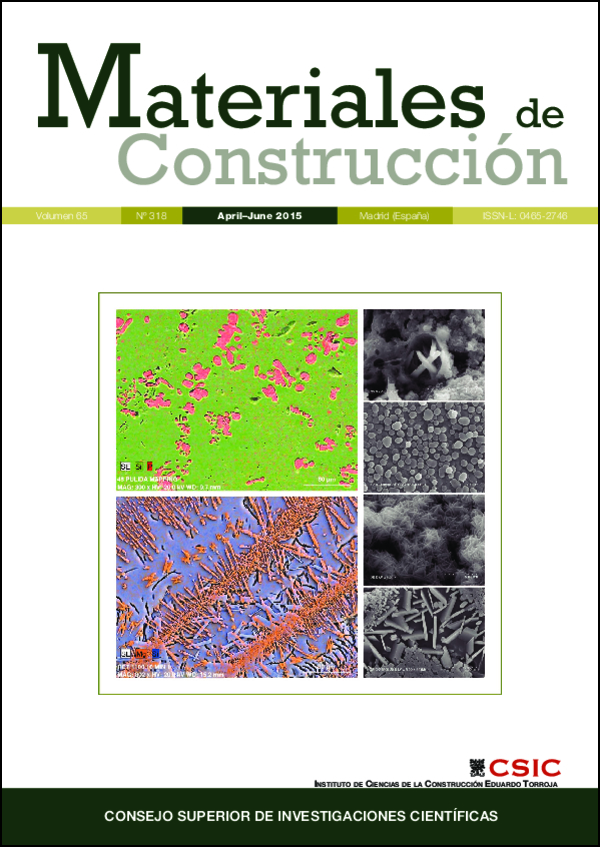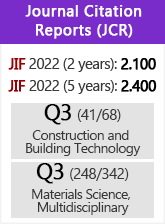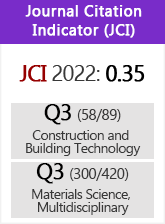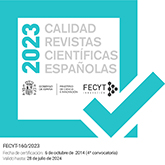Performance at high temperature of alkali-activated slag pastes produced with silica fume and rice husk ash based activators
DOI:
https://doi.org/10.3989/mc.2015.03114Keywords:
Alkali-activated cements, Blast furnace slag, Temperature, Physical properties, CharacterisationAbstract
This study assessed the mechanical properties, and structural changes induced by high temperature exposure, of alkali-silicate activated slag cements produced with sodium silicates derived from silica fume (SF) and rice husk ash (RHA). Similar reaction products were identified, independent of the type of silicate used, but with subtle differences in the composition of the C-S-H gels, leading to different strength losses after elevated temperature exposure. Cements produced with the alternative activators developed higher compressive strengths than those produced with commercial silicate. All samples retained strengths of more than 50 MPa after exposure to 600 °C, however, after exposure to 800 °C only the specimens produced with the RHA-based activator retained measurable strength. This study elucidated that silicate-activated slag binders, either activated with commercial silicate solutions or with sodium silicates based on SF or RHA, are stable up to 600 °C.
Downloads
References
1. Delhomme, F.; Ambroise, J.; Limam, A. (2012) Effects of high temperatures on mortar specimens containing Portland cement and GGBFS. Mater. Struct. 45 [11], 1685–1692. http://dx.doi.org/10.1617/s11527-012-9865-7
2. Matesová, D.; Bonen, D.; Shah, S.P. (2006) Factors affecting the resistance of cementitious materials at high temperatures and medium heating rates. Mater. Struct. 39 [9], 919–935. http://dx.doi.org/10.1617/s11527-006-9198-5
3. Handoo, S.K.; Agarwal, S.; Agarwal, S.K. (2002) Physicochemical, mineralogical, and morphological characteristics of concrete exposed to elevated temperatures. Cem. Concr. Res. 32, 1009–1018. http://dx.doi.org/10.1016/S0008-8846(01)00736-0
4. Alarcon-Ruíz, L.; Platret, G.; Massieu, E.; Ehrlacher, A. (2005) The use of thermal analysis in assessing the effect of temperature on a cement paste. Cem. Concr. Res. 35, 609–613. http://dx.doi.org/10.1016/j.cemconres.2004.06.015
5. Provis, J.L. (2014) Geopolymers and other alkali activated materials: why, how, and what? Mater. Struct. 47, 11–25. http://dx.doi.org/10.1617/s11527-013-0211-5
6. Juenger, M.C.G.; Winnefeld, F.; Provis, J.L.; Ideker, J. (2011) Advances in alternative cementitious binders. Cem. Concr. Res. 41, 1232–1243. http://dx.doi.org/10.1016/j.cemconres.2010.11.012
7. Provis, J.L.; Bernal, S.A. (2014) Geopolymers and related alkali-activated materials. Annu. Rev. Mater. Res. 44, 299–327. http://dx.doi.org/10.1146/annurev-matsci-070813-113515
8. Bernal, S.A.; San Nicolas, R.; Myers, R.J.; Mejía de Gutiérrez, R.; Puertas, F.; van Deventer, J.S.J.; Provis, J.L. (2014) MgO content of slag controls phase evolution and structural changes induced by accelerated carbonation in alkali-activated binders. Cem. Concr. Res. 57, 33–43. http://dx.doi.org/10.1016/j.cemconres.2013.12.003
9. Palomo, A.; Krivenko, P.; Garcia-Lodeiro, I.; Kavalerova, E.; Maltseva, O.; Fernández-Jiménez, A. (2014) A review on alkaline activation: new analytical perspectives. Mater. Construcc. 64 [315].
10. Guerrieri, M.; Sanjayan, J.G. (2010) Behavior of combined fly ash/slag-based geopolymers when exposed to high temperatures. Fire Mater. 34 [4], 163–175.
11. Puertas, F.; Gil-Maroto, A.; Palacios, M.; Amat, T. (2006) Alkali-activated slag mortars reinforced with AR glassfibre. Performance and properties. Mater. Construcc. 56 [283], 79–90.
12. Kong, D.L.Y.; Sanjayan, J.G. (2010) Effect of elevated temperatures on geopolymer paste, mortar and concrete. Cem. Concr. Res. 40, 334–339. http://dx.doi.org/10.1016/j.cemconres.2009.10.017
13. Bernal, S.A.; Rodríguez, E.D.; Mejía de Gutierrez, R.; Gordillo, M.; Provis, J.L. (2011) Mechanical and thermal characterisation of geopolymers based on silicate-activated metakaolin/slag blends. J. Mater. Sci. 46, 5477–5486. http://dx.doi.org/10.1007/s10853-011-5490-z
14. Bernal, S.A.; Mejía de Gutiérrez, R.; Ruiz, F.; Qui-ones, H.; Provis, J.L. (2012) High-temperature performance of mortars and concretes based on alkali-activated slag/metakaolin blends. Mater. Constr. 62, 471–488. http://dx.doi.org/10.3989/mc.2012.01712
15. Rickard, W.D.A.; Williams, R.; Temuujin, J.; van Riessen, A. (2011) Assessing the suitability of three Australian fly ashes as an aluminosilicate source for geopolymers in high temperature applications. Mater. Sci. Eng. A 528, 3390–3397. http://dx.doi.org/10.1016/j.msea.2011.01.005
16. Rashad, A.M.; Bai, Y.; Basheer, P.A.M.; Collier, N.C.; Milestone, N.B. (2012) Chemical and mechanical stability of sodium sulfate activated slag after exposure to elevated temperature. Cem. Concr. Res. 42, 333–343. http://dx.doi.org/10.1016/j.cemconres.2011.10.007
17. Mejía de Gutiérrez, R.; Maldonado, J.; Gutiérrez, C. (2004) Resistencia a temperaturas elevadas de escoria activadas alcalinamente. Mater. Constr. 54, 87–92. http://dx.doi.org/10.3989/mc.2004.v54.i276.257
18. Guerrieri, M.; Sanjayan, J.; Collins, F. (2009) Residual compressive behavior of alkali-activated concrete exposed to elevated temperatures. Fire Mater. 33, 51–62. http://dx.doi.org/10.1002/fam.983
19. Guerrieri, M.; Sanjayan, J.; Collins, F. (2010) Residual strength properties of sodium silicate alkali activated slag paste exposed to elevated temperatures. Mater. Struct. 43, 765–773. http://dx.doi.org/10.1617/s11527-009-9546-3
20. Zuda, L.; Drchalová, J.; Rovnaník, P.; Bayer, P.; Keršner, Z.; Cerny, R. (2010) Alkali-activated aluminosilicate composite with heat-resistant lightweight aggregates exposed to high temperatures: Mechanical and water transport properties. Cem. Concr. Compos. 32, 157–163. http://dx.doi.org/10.1016/j.cemconcomp.2009.11.009
21. Zuda, L.; Cˇerny´, R. (2009) Measurement of linear thermal expansion coefficient of alkali-activated aluminosilicate composites up to 1000 °C. Cem. Concr. Compos. 31, 263–267. http://dx.doi.org/10.1016/j.cemconcomp.2009.02.002
22. Rovnaník, P.; Bayer, P.; Rovnaníková, P. (2013) Characterization of alkali activated slag paste after exposure to high temperatures. Constr. Build. Mater. 47, 1479–1487. http://dx.doi.org/10.1016/j.conbuildmat.2013.06.070
23. Živica, V. (2006) Effectiveness of new silica fume alkali activator. Cem. Concr. Compos. 28, 21–25. http://dx.doi.org/10.1016/j.cemconcomp.2005.07.004
24. Živica, V. (2004) High effective silica fume alkali activator. Bull. Mater. Sci. 27, 179–182. http://dx.doi.org/10.1007/BF02708502
25. Rouseková, I.; Bajza, A.; Živica, V. (1997) Silica fume-basic blast furnace slag systems activated by an alkali silica fume activator. Cem. Concr. Res. 27, 1825–1828. http://dx.doi.org/10.1016/S0008-8846(97)00191-9
26. Rodríguez, E.D.; Bernal, S.A.; Provis, J.L.; Paya, J.; Monzo, J.M.; Borrachero, M.V. (2013) Effect of nanosilica- based activators on the performance of an alkali-activated fly ash binder. Cem. Concr. Compos. 35, 1–11. http://dx.doi.org/10.1016/j.cemconcomp.2012.08.025
27. Mejía, J.M.; Mejía de Gutiérrez, R.; Puertas, F. (2013) Rice husk ash as a source of silica in alkali-activated fly ash and granulated blast furnace slag systems. Mater. Constr. 63, 361–375.
28. Bernal, S.A.; Rodríguez, E.D.; Mejía de Gutierrez, R.; Provis, J.L.; Delvasto, S. (2012) Activation of metakaolin/slag blends using alkaline solutions based on chemically modified silica fume and rice husk ash. Waste Biomass Valoriz. 3, 99–108. http://dx.doi.org/10.1007/s12649-011-9093-3
29. Torres-Carrasco, M.; Palomo, J. G.; Puertas, F. (2014) Sodium Silicate from dissolution of glass wastes. Statistical analyses. Mater. Construcc. 64 [314].
30. Salas, A.; Delvasto, S.; Mejía de Gutierrez, R.; Lange, D. (2009) Comparison of two processes for treating rice husk ash for use in high performance concrete. Cem. Concr. Res. 39, 773–778. http://dx.doi.org/10.1016/j.cemconres.2009.05.006
31. Bernal, S.A.; Provis, J.L.; Mejía de Gutierrez, R.; Rose, V. (2011) Evolution of binder structure in sodium silicate-activated slag-metakaolin blends. Cem. Concr. Compos. 33, 46–54. http://dx.doi.org/10.1016/j.cemconcomp.2010.09.004
32. Yu, Q.; Sawayama, K.; Sugita, S.; Shoya, M.; Isojima, Y. (1999) The reaction between rice husk ash and Ca(OH)2 solution and the nature of its product. Cem. Concr. Res. 29, 37–43. http://dx.doi.org/10.1016/S0008-8846(98)00172-0
33. Lee, W.K.W.; van Deventer, J.S.J. (2003) Use of infrared spectroscopy to study geopolymerization of heterogeneous amorphous aluminosilicates. Langmuir 19, 8726–8734. http://dx.doi.org/10.1021/la026127e
34. Yu, P.; Kirkpatrick, R.J.; Poe, B.; McMillan, P.F.; Cong, X. (1999) Structure of calcium silicate hydrate (C-S-H): Near-, mid-, and far-infrared spectroscopy. J. Am. Ceram. Soc. 82 [3], 742–48. http://dx.doi.org/10.1111/j.1151-2916.1999.tb01826.x
35. García Lodeiro, I.; Macphee, D.E.; Palomo, A.; Fernández-Jiménez, A. (2009) Effect of alkalis on fresh C-S-H gels. FTIR analysis. Cem. Concr. Res. 39, 147–153. http://dx.doi.org/10.1016/j.cemconres.2009.01.003
36. García-Lodeiro, I.; Fernández-Jiménez, A.; Blanco, M.T.; Palomo, A. (2008) FTIR study of the sol-gel synthesis of cementitious gels: C-S-H and N-A-S-H. J. Sol-Gel. Sci. Technol. 45, 63–72. http://dx.doi.org/10.1007/s10971-007-1643-6
37. Reig, F.B.; Adelantado, J.V.G.; Moya Moreno, M.C.M. (2002) FTIR quantitative analysis of calcium carbonate (calcite) and silica (quartz) mixtures using the constant ratio method. Application to geological samples. Talanta 58, 811–821. http://dx.doi.org/10.1016/S0039-9140(02)00372-7
38. Siriwardane, R.V.; Shen, M.-S.; Fisher, E.P.; Losch, J. (2005) Adsorption of CO2 on Zeolites at Moderate Temperatures. Energ. Fuel 19, 1153–1159. http://dx.doi.org/10.1021/ef040059h
39. Stevens, R.W.; Siriwardane, R.V.; Logan, J. (2008) In situ Fourier transform infrared (FTIR) investigation of CO2 adsorption onto zeolite materials. Energ. Fuel 22, 3070–3079. http://dx.doi.org/10.1021/ef800209a
40. Holmgren, A.; Wu, L.; Forsling, W. (1994) Surface hydration of aqueous calcium minerals as studied by Fourier transform Raman and infrared spectroscopy. Spectrochim. Acta, Part A 50, 1857–1869. http://dx.doi.org/10.1016/0584-8539(94)80198-3
Published
How to Cite
Issue
Section
License
Copyright (c) 2015 Consejo Superior de Investigaciones Científicas (CSIC)

This work is licensed under a Creative Commons Attribution 4.0 International License.
© CSIC. Manuscripts published in both the printed and online versions of this Journal are the property of Consejo Superior de Investigaciones Científicas, and quoting this source is a requirement for any partial or full reproduction.All contents of this electronic edition, except where otherwise noted, are distributed under a “Creative Commons Attribution 4.0 International” (CC BY 4.0) License. You may read here the basic information and the legal text of the license. The indication of the CC BY 4.0 License must be expressly stated in this way when necessary.
Self-archiving in repositories, personal webpages or similar, of any version other than the published by the Editor, is not allowed.


















